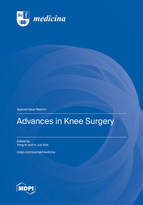Advances in Knee Surgery
A special issue of Medicina (ISSN 1648-9144). This special issue belongs to the section "Surgery".
Deadline for manuscript submissions: closed (31 May 2023) | Viewed by 53595
Special Issue Editors
Interests: knee osteoarthritis; cartilage regeneration; arthroplasty implant design
Special Issue Information
Dear Colleagues,
In the orthopaedic surgical field, knee surgeries have made great progress over the last decade including ligament, meniscus, and cartilage surgeries, osteotomy, and arthroplasty.
The main aim of this Special Issue of Medicina is to showcase new advances in knee surgeries for various patients suffering from knee injuries and diseases. This Special Issue is open to studies for new surgical techniques, surgical strategies and decision making, clinical outcomes, and systematic reviews and meta-analyses.
The aim of this Special Issue will be to deliver new insight into the advanced knee surgeries. Papers focused on updates in knee surgeries are strongly encouraged.
- Ligament surgery: repairs and reconstructions
- Meniscus surgery: repairs, reconstructions, and meniscal allograft transplantations
- Cartilage surgery: advanced marrow stimulation techniques, cell implantations, and stem-cell implantations
- Osteotomy: femoral or tibial osteotomies, double-level osteotomies, and new fixatives
- Arthroplasty: advances in techniques in unicompartmental or total arthroplasties
Authors can submit their technical notes, surgical strategies and decision making, clinical outcome studies, comparative studies, and systematic reviews and meta-analyses for new surgical techniques.
Prof. Dr. Yong In
Prof. Dr. In Jun Koh
Guest Editors
Manuscript Submission Information
Manuscripts should be submitted online at www.mdpi.com by registering and logging in to this website. Once you are registered, click here to go to the submission form. Manuscripts can be submitted until the deadline. All submissions that pass pre-check are peer-reviewed. Accepted papers will be published continuously in the journal (as soon as accepted) and will be listed together on the special issue website. Research articles, review articles as well as short communications are invited. For planned papers, a title and short abstract (about 100 words) can be sent to the Editorial Office for announcement on this website.
Submitted manuscripts should not have been published previously, nor be under consideration for publication elsewhere (except conference proceedings papers). All manuscripts are thoroughly refereed through a single-blind peer-review process. A guide for authors and other relevant information for submission of manuscripts is available on the Instructions for Authors page. Medicina is an international peer-reviewed open access monthly journal published by MDPI.
Please visit the Instructions for Authors page before submitting a manuscript. The Article Processing Charge (APC) for publication in this open access journal is 1800 CHF (Swiss Francs). Submitted papers should be well formatted and use good English. Authors may use MDPI's English editing service prior to publication or during author revisions.
Keywords
- knee ligament injury
- meniscus tear
- knee cartilage injury
- knee osteoarthritis
- knee osteotomy
- knee arthroplasty








